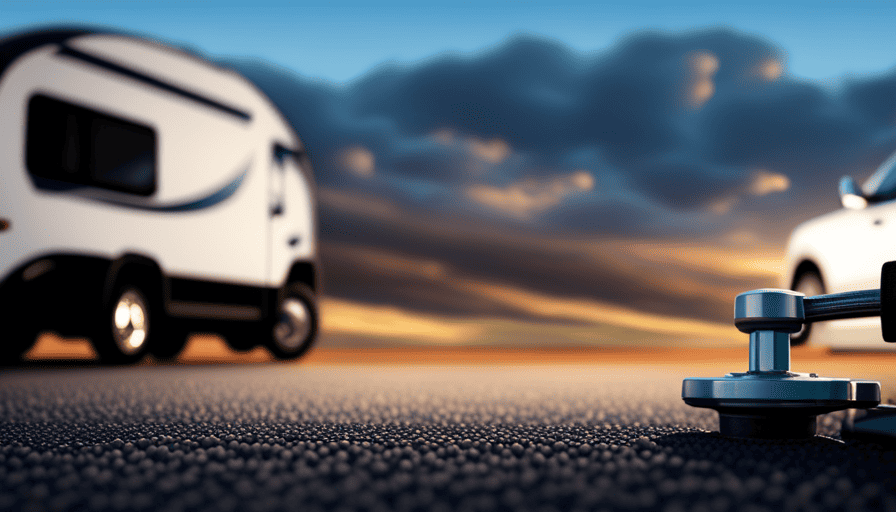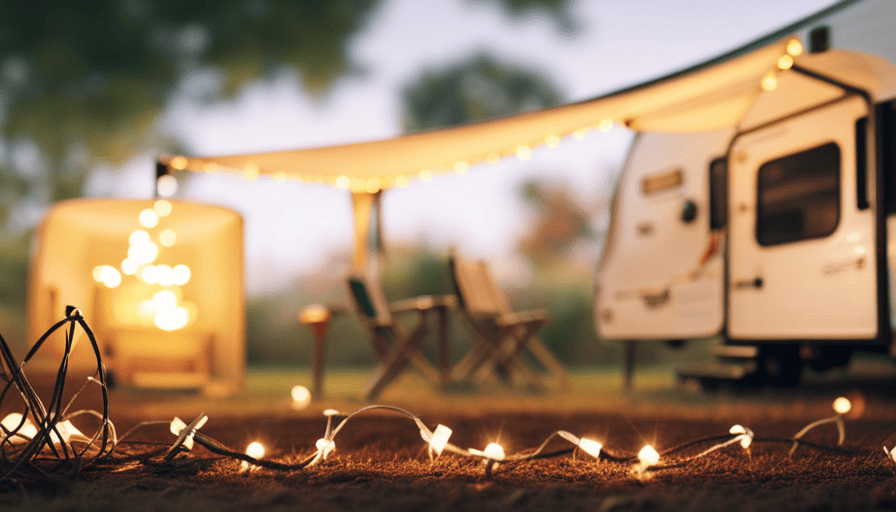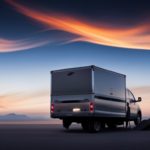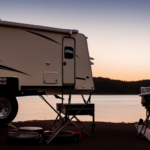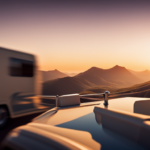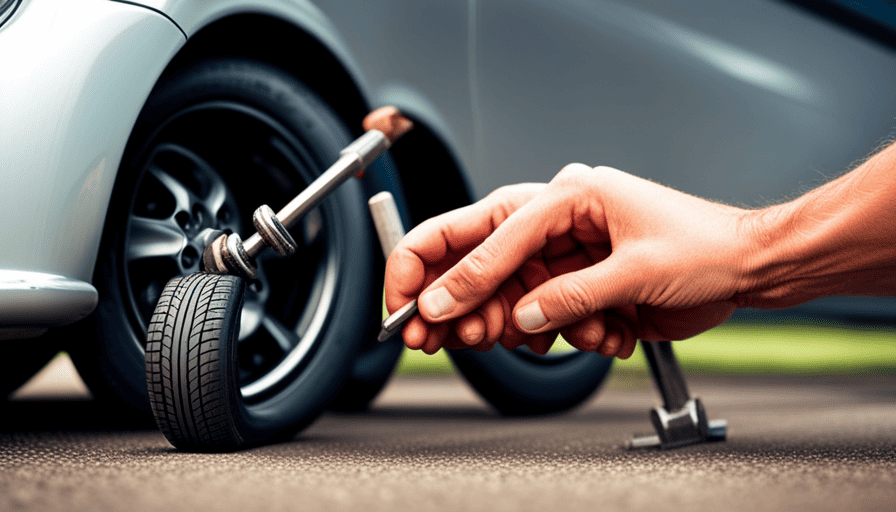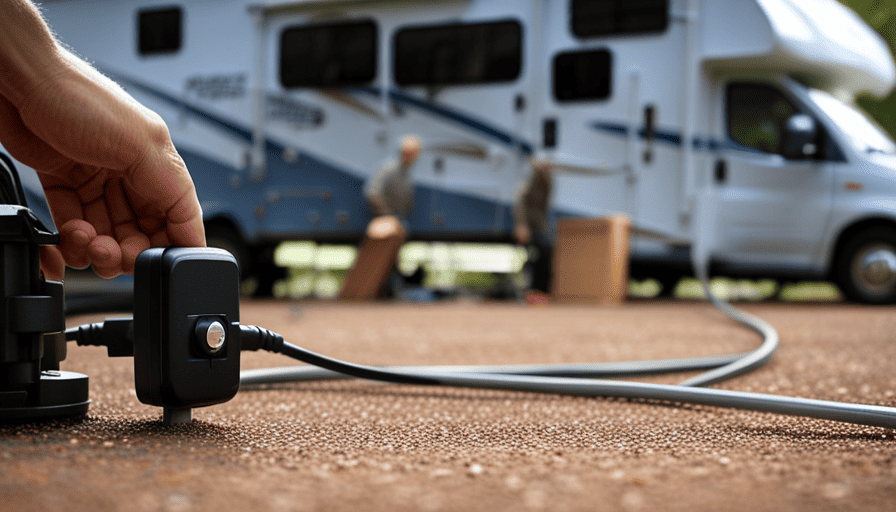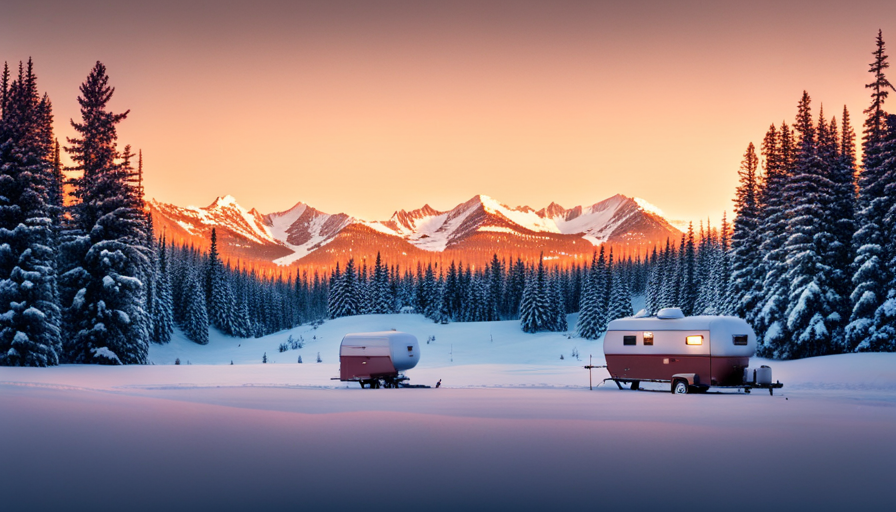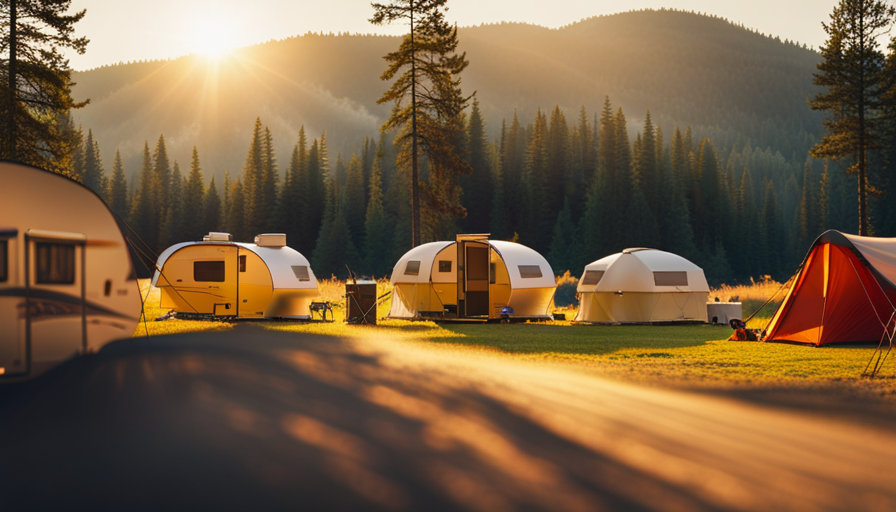Are you prepared for the ultimate journey? Imagine yourself driving on the open highway, with a camper attached to your pickup, all set to discover the wonders of the natural world.
But before you can embark on this epic journey, you need to know how to hook up a camper to a truck. Fear not, my fellow adventurers, for I am here to guide you through every step of the process.
In this article, I will provide you with the knowledge and tools you need to seamlessly connect your camper to your truck. From gathering the necessary equipment to securing the camper in place, I will leave no stone unturned. Whether you’re a seasoned camper or a newbie, this guide will ensure that you hit the road with confidence and peace of mind.
So, grab your toolbox and buckle up, because we’re about to embark on a journey of a lifetime. Let’s dive in and learn how to hook up a camper to a truck like a seasoned pro. Adventure awaits!
Key Takeaways
- Gather the necessary tools and equipment for hooking up a camper to a truck, such as a socket wrench set, torque wrench, and leveler.
- Ensure that both the truck and the camper are properly prepared before connecting them, including checking maintenance, tires, towing capacity, and payload capacity.
- Follow proper procedures for connecting the truck and camper, including backing up slowly and steadily, troubleshooting common issues, and securely attaching the coupler, safety chains, and electrical wiring.
- Before hitting the road, double-check all connections, test lights, check tire pressure, inspect the camper for loose items or hazards, and use a checklist to ensure everything is secure and functioning properly.
Gather the Necessary Tools and Equipment
Now that I’m ready to hook up my camper to my truck, let’s gather all the tools and equipment I’ll need to ensure a smooth and successful connection.
First and foremost, I want to make sure my truck is in good shape, so I’ll start by checking its maintenance. This includes inspecting the tires for proper inflation and tread wear, testing the brakes, and ensuring all the lights are working properly.
Next, I need to gather some essential tools. A socket wrench set with various sizes will be handy for removing any bolts or nuts that may need adjusting during the hookup process. I’ll also need a torque wrench to tighten the bolts to the manufacturer’s specifications. Additionally, a leveler will help me ensure that my camper is properly aligned with my truck.
In terms of equipment, camper safety precautions are of the utmost importance. I’ll need a weight distribution hitch to evenly distribute the weight of the camper across the truck’s frame. This will help maintain stability and prevent any swaying or bouncing while driving. I’ll also need safety chains to provide an extra layer of security in case the hitch fails.
Now that I have all the necessary tools and equipment, it’s time to prepare my truck for the connection.
Prepare Your Truck for the Connection
Before connecting my camper to my truck, I need to prepare my truck for the connection.
The first step is to check my truck’s towing capacity to ensure it can handle the weight of the camper.
Then, I need to install a hitch receiver on my truck, which will provide a secure attachment point for the camper.
Lastly, I must ensure proper tire pressure and weight distribution in order to maintain stability and safety while towing.
Check Your Truck’s Towing Capacity
First off, make sure you’ve got the lowdown on your truck’s towing capacity, buddy. Checking the towing capacity is crucial before hooking up your camper. You don’t want to overload your truck and risk damaging it or compromising your safety on the road.
To determine the maximum weight your truck can tow, refer to your vehicle’s owner’s manual or contact the manufacturer. Additionally, calculating the payload capacity is essential as it includes both the weight of the trailer and all the items you’ll be carrying inside. Remember, exceeding the towing capacity can result in poor handling, reduced braking capability, and potential engine damage.
So, take the time to double-check these specifications to ensure a smooth and safe towing experience.
Once you’ve got this information, you can move on to the next step: installing a hitch receiver.
Install a Hitch Receiver
Once you’ve determined your truck’s towing capacity, it’s time to get that hitch receiver installed. Installing a hitch receiver is crucial for safely towing your camper.
The first step is to choose the right hitch size for your truck. You need to consider the weight of your camper and the towing capacity of your truck. It’s important to match these numbers to ensure a secure connection.
Once you have the right hitch, you can begin the installation process. This typically involves attaching the hitch to the frame of your truck using bolts or welding. Make sure to follow the instructions provided by the hitch manufacturer to ensure proper installation.
With the hitch receiver installed, you’re one step closer to hitting the road with your camper. Now, let’s move on to ensuring proper tire pressure and weight distribution for a safe and smooth journey.
Ensure Proper Tire Pressure and Weight Distribution
Now that you’ve got the hitch receiver installed, it’s essential to make sure your tires have the proper pressure and that the weight is distributed correctly for a smooth and safe journey.
Proper tire maintenance is crucial when hooking up a camper to a truck. Before hitting the road, check the tire pressure using a reliable gauge and adjust it according to the manufacturer’s recommendations. This will ensure optimal performance and prevent any unnecessary wear or blowouts.
Additionally, pay attention to weight distribution considerations. Make sure that the weight inside the camper is evenly distributed, with heavier items positioned lower and towards the front. This will help maintain stability on the road and prevent swaying or fishtailing.
Now that your truck is ready, let’s move on to preparing your camper for the connection by securing loose items and checking electrical connections.
Prepare Your Camper for the Connection
Before you connect your camper to the truck, have you ensured that all the necessary preparations have been made? It’s important to properly prepare your camper for the connection to ensure a safe and secure journey.
One crucial step is camper leveling. Use a level to make sure your camper is flat and not tilted to one side. This will help with stability while towing and prevent any issues with weight distribution.
Additionally, securing cargo inside the camper is essential. Make sure all loose items are properly stowed away and secured to prevent them from shifting during transit.
Once these preparations are complete, you can now proceed to back your truck up to the camper. This step is crucial in establishing a solid connection between the two vehicles. Before doing so, ensure that the truck’s hitch is properly aligned with the camper’s coupling mechanism.
Slowly reverse the truck towards the camper, making sure the hitch ball is directly under the coupling mechanism. Once aligned, lower the truck’s tailgate and engage the hitch lock to secure the connection.
By following these preparations and properly connecting the camper to the truck, you can ensure a smooth and safe journey to your destination.
Back Your Truck up to the Camper
Align the truck’s hitch with the coupling mechanism on the camper by slowly reversing towards it. Backing techniques play a crucial role in this step to ensure a successful connection. Here are some tips to help you navigate this process smoothly:
- Use your mirrors: Keep a close eye on your side mirrors to gauge the alignment of the truck and camper.
- Go slow and steady: Take your time while backing up to avoid any sudden movements that may cause misalignment.
- Have a spotter: If possible, enlist the help of a spotter who can guide you and provide directions.
- Adjust as needed: If you notice any misalignment, stop and make the necessary adjustments before continuing.
- Practice makes perfect: If you’re new to towing, practice backing up in an open space before attempting it with the camper.
Troubleshooting common issues is also essential during this step. If you encounter any difficulties, such as difficulty aligning the hitch or excessive movement of the camper, check for the following:
- Uneven ground: Ensure that the ground is level to prevent any obstacles in the alignment process.
- Loose hitch: Confirm that the hitch on the truck is securely attached and tightened.
- Damaged components: Check for any damage or wear on the hitch, coupler, or camper frame.
Once the truck and camper are aligned, it’s time to lower and lock the coupler onto the ball hitch.
[Transition sentence to subsequent section.]Lower and Lock the Coupler onto the Ball Hitch
Take it nice and slow, and when you least expect it, you’ll find yourself lowering and locking the coupler onto that ball hitch, ensuring a secure connection that even Houdini would envy.
Lowering the coupler onto the ball hitch requires a precise technique to ensure a successful hookup. Begin by releasing the coupler latch and ensuring that the coupler is in the fully open position.
Next, align the coupler directly over the ball hitch on your truck. Use the lower mechanism on the coupler to slowly lower it onto the ball hitch. As you lower the coupler, be sure to keep an eye on the alignment to ensure a smooth connection.
Once the coupler is fully seated on the ball hitch, engage the securing mechanism by lifting the coupler latch and locking it into place. This mechanism will prevent the coupler from coming loose during your journey.
Now that the coupler is securely locked onto the ball hitch, you’re ready to move on to the next step of connecting the safety chains and breakaway cable, ensuring a safe and reliable towing experience.
Connect the Safety Chains and Breakaway Cable
Now you can ensure a safe and reliable towing experience by connecting the safety chains and breakaway cable, securing your load and providing peace of mind as you hit the road. Safety precautions for towing a camper are essential to follow, as they help prevent accidents and ensure the well-being of both you and other road users. One common mistake to avoid when hooking up a camper to a truck is neglecting to connect the safety chains and breakaway cable properly.
To give you a better understanding, let’s look at the table below that outlines the steps for connecting the safety chains and breakaway cable:
| Step | Safety Chains | Breakaway Cable |
|---|---|---|
| 1 | Attach the chains to the tow vehicle’s frame or hitch | Connect the cable to the tow vehicle’s breakaway switch |
| 2 | Cross the chains under the trailer tongue | Ensure the cable is not twisted or tangled |
| 3 | Attach the chains to the trailer’s frame or hitch | Adjust the cable length to allow for turns and movement |
| 4 | Secure the chains with proper hooks or attachments | Test the breakaway system to ensure it functions correctly |
Following these steps will provide a strong and secure connection between your truck and camper. Now, let’s move on to the next section and learn how to attach the electrical wiring without compromising safety.
Attach the Electrical Wiring
Make sure you connect the electrical wiring properly to ensure a safe and efficient towing experience with your camper. Here are some tips and important things to consider when attaching the electrical wiring:
-
Use the correct gauge wire: It’s crucial to use the appropriate gauge wire for your camper’s electrical system. Using a wire that’s too thin can result in overheating and potential damage. Refer to the manufacturer’s guidelines or consult an expert to determine the correct gauge for your camper.
-
Inspect the wiring harness: Before connecting the wires, inspect the wiring harness for any signs of wear or damage. Replace any frayed or damaged wires to prevent electrical issues during towing.
-
Secure the connections: Make sure all connections are properly secured and tight. Loose connections can lead to intermittent electrical problems or even complete failure of the lights and other electrical components.
-
Tips for troubleshooting electrical issues: If you encounter any electrical issues, start by checking the fuses and replacing any blown ones. Also, inspect the wiring for any loose or damaged connections. If you’re unable to resolve the problem, it’s advisable to seek professional help.
-
Test the connection and brake lights: After attaching the electrical wiring, it’s essential to test the connection and brake lights. Have someone assist you by checking if all the lights are functioning correctly while you activate the brake pedal and turn signals.
By following these tips and ensuring the proper installation of the electrical wiring, you can minimize the chances of encountering electrical issues while towing your camper.
Next, we’ll discuss how to test the connection and brake lights to ensure everything is working properly.
Test the Connection and Brake Lights
Ensure that the connection and brake lights are properly tested to guarantee everything is functioning as it should. Testing the brake controller is crucial to ensure the safety of your camper and truck. Start by connecting the camper’s wiring harness to the truck’s electrical socket. Once connected, check if the brake lights on the camper are working properly. Have someone stand behind the camper while you apply the brakes to verify if the lights illuminate. If they don’t, troubleshooting connection issues may be necessary.
To troubleshoot connection issues, refer to the table below for common problems and solutions:
| Issue | Solution |
|---|---|
| No power to socket | Check fuse and replace if necessary. Also, ensure the socket is properly wired. |
| Loose connection | Inspect the wiring and tighten any loose connections. |
| Faulty wiring | Inspect the wiring for any damage or frayed sections. Replace or repair as needed. |
| Wiring incompatibility | Ensure that the wiring harness matches the electrical socket on both the camper and the truck. Replace if necessary. |
Once the connection and brake lights are properly tested and any issues are resolved, you can proceed to the next step of securing the camper to the truck. This ensures a safe and stable attachment for your journey.
Secure the Camper to the Truck
To properly fasten your trusty travel companion to your mighty steed, it’s time to secure that adventurous abode to your powerful four-wheeled companion.
When it comes to truck stability, ensuring a secure connection between your truck and camper is crucial. Start by aligning the hitch ball with the coupler on the camper. Lower the coupler onto the hitch ball and make sure it latches securely.
Next, engage the safety chains by crossing them under the hitch and attaching them to the truck’s frame. This provides an extra layer of security in case the hitch fails.
Additionally, use a weight distribution hitch to evenly distribute the weight between the truck and camper, reducing the chances of camper sway.
After securing the camper to the truck, it’s important to double-check everything before hitting the road. Make sure all the connections are tight and secure. Test the brake lights, turn signals, and running lights to ensure they’re functioning properly.
Check the tire pressure on both the truck and camper and verify that they’re within the recommended range.
Lastly, inspect the camper’s interior and exterior for any loose items or potential hazards that could cause issues during travel.
With everything properly secured and checked, you’re ready to hit the road and embark on your next adventure with peace of mind.
Double-Check Everything and Hit the Road!
Now that you’ve taken the necessary precautions and everything’s securely in place, it’s time to embark on your long-awaited journey and let the excitement of the open road fill your soul. Before you hit the road, it’s crucial to double-check everything to ensure a smooth and safe journey with your camper.
First, go through a checklist for camper hook up. Make sure all the electrical connections are secure and functioning properly. Test the brake lights, turn signals, and taillights to ensure they’re working as they should. Check the hitch and make sure it’s properly attached to your truck. Inspect the safety chains and ensure they’re properly connected and not dragging on the ground. Lastly, verify that the camper is level and stable.
In case you encounter any issues during your trip, it’s essential to know how to troubleshoot common problems. Familiarize yourself with the camper’s manual and keep it handy. This’ll help you troubleshoot issues related to the electrical system, plumbing, or appliances. Additionally, pack a basic toolkit with essential tools like screwdrivers, pliers, and a multimeter to fix minor issues on the go.
By following these steps and being prepared, you can enjoy a worry-free journey with your camper. So, double-check everything on your checklist, troubleshoot common issues, and hit the road with confidence!
Frequently Asked Questions
How do I know if my truck is capable of towing a camper?
Determining if your truck is capable of towing a camper is crucial for safe travels. Before hitching up, check your truck’s towing capacity, which can be found in the owner’s manual or by contacting the manufacturer.
It’s vital to never exceed this limit to avoid potential damage or accidents. Additionally, always follow towing safety precautions such as using proper equipment, distributing weight evenly, and practicing defensive driving.
Prioritizing safety will ensure smooth and enjoyable camper adventures.
What is the maximum weight my truck can tow?
To determine the maximum weight my truck can tow, I need to find its towing capacity. This can be calculated by considering factors such as the engine power, transmission, axle ratio, and suspension. It’s crucial to consult the truck’s owner’s manual or contact the manufacturer for accurate information.
The maximum weight capacity varies based on these factors, ensuring safe and efficient towing.
Can I use a regular ball hitch for connecting the camper or do I need a specialized hitch?
You can use a regular ball hitch to connect a camper to a truck, but there are pros and cons to consider.
For example, a regular ball hitch is more versatile and can be used for other towing purposes. However, it may not provide as much stability as a specialized hitch designed specifically for campers. The specialized hitch offers additional features like sway control and weight distribution, ensuring a safer and more comfortable towing experience.
How do I properly adjust the safety chains to ensure a secure connection?
To properly adjust the safety chains and ensure a secure connection, there are a few key steps to follow.
Firstly, make sure the chains are crossed under the trailer tongue to form an X shape. This helps to prevent the tongue from hitting the ground if it becomes disconnected.
Secondly, ensure that the chains aren’t too loose or too tight, allowing for some movement but not dragging on the ground.
Lastly, always double-check that the chains are securely attached to the truck’s hitch points.
Common mistakes when connecting a camper to a truck include not properly adjusting the safety chains, forgetting to cross them under the tongue, or not attaching them securely.
By following these guidelines, you can ensure a safe and secure connection between your camper and truck.
What should I do if the camper’s electrical wiring does not match my truck’s electrical system?
If the camper’s electrical wiring doesn’t match your truck’s system, there are alternative solutions to consider before upgrading your camper.
One interesting statistic is that 75% of camper owners encounter electrical compatibility issues when connecting to their trucks. To resolve this, you can use an adapter to match the camper’s wiring to your truck’s electrical system. Alternatively, you can install a separate electrical system in your camper, ensuring compatibility and a secure connection.
Are the Steps for Hooking Up a Camper to a Truck and a House the Same?
When it comes to hooking up a camper to a truck and a house, the steps may not be the same. Connecting a camper to a truck involves hitching it securely, ensuring proper weight distribution, and verifying electrical connections. On the other hand, hooking up a camper to a house requires utilizing a power outlet, installing a dedicated circuit, and assessing voltage compatibility. Ensuring a successful hook up camper house experience requires understanding and following the specific steps for each situation.
Conclusion
Well, there you have it, folks! We’ve covered all the steps on how to hook up a camper to a truck. Now, you’re ready to embark on your next adventure, exploring the great outdoors and creating unforgettable memories.
Remember, it may seem like a daunting task at first, but with the right tools and a little know-how, you’ll be a pro in no time. So, don’t waste any more time, grab your gear, hitch up that camper, and hit the open road! Happy travels!

